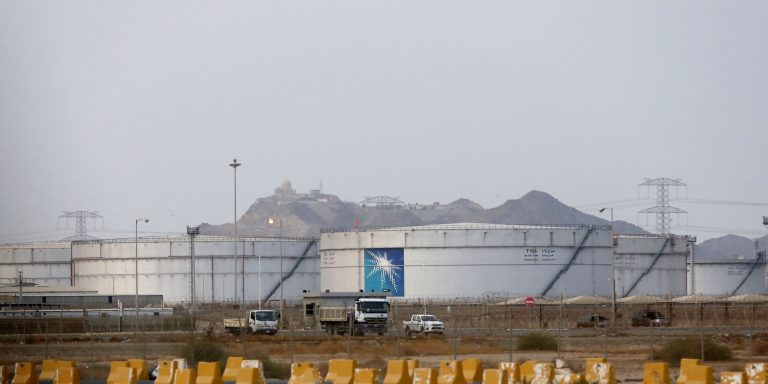INTELBRIEF
September 16, 2019
IntelBrief: Houthis Drone Attack Targets Major Saudi Oil Facilities

- Over the weekend, Houthi rebels launched a drone attack against Saudi Arabia, targeting the Saudi Aramco crude stabilization facility in Abqaiq and an oil field at Hijra Khurais with ten drones.
- Despite Saudi Arabia spending untold sums on missile defense, Houthi-operated drones have been able to permeate Saudi airspace and strike with alarming precision.
- The increased operational tempo of Houthi drone attacks appears to be an escalation of the shadow war between Tehran and Riyadh.
- The ongoing campaign of drone attacks by the Houthis is designed to increase the stakes for the Saudis and force the leadership to rethink the wisdom of continuing its war in Yemen
Over the weekend, Houthi rebels in Yemen once again launched a drone attack against Saudi Arabia, with the most recent incident targeting the Saudi Aramco crude stabilization facility in Abqaiq and an oil field at Hijra Khurais. The attack involved the use of ten drones and resulted in a fire at the facility, forcing the Saudis to partially cease production. The shutdown led to a loss of the equivalent of 5 million barrels per day, or approximately five percent of global crude oil production. Not only are the attacks harmful to the global economy because of dependence on Saudi oil, but targeting infrastructure also endangers civilian employees who may be working at these installations. The attacks could send shockwaves through world financial markets and will likely lead to higher energy prices, with countries like that rely heavily on energy imports, including China and Japan, suffering the most. United Nations envoy Martin Griffiths called the apparent escalation by the Houthis' extremely worrying' and urged all parties to find a way to deescalate tensions. U.S. Secretary of State Mike Pompeo blamed Iran, but Tehran dismissed the allegations. Trump administration officials have indicated that the attack consisted of more than just drones, suggesting that cruise missiles were involved, and blaming Iran as the main instigator of the strikes. Secretary of State Pompeo asserted that the U.S. believes the strikes did not emanate from Yemen, as many have claimed.
Saudi Aramco, which is preparing for an initial public offering (IPO), called an emergency board meeting to discuss the consequences of the recent attack and map out a path forward. Continued attacks against Saudi oil facilities will inevitably leave investors and energy analysts concerned. U.S. President Trump called Saudi Crown Prince Mohammed bin Salman to offer American support and reiterated his concern for the stability of global financial markets. Bin Salman suggested that Saudi Arabia was both ‘willing and able’ to respond to the attack. Despite Saudi Arabia spending untold sums on missile defense, Houthi-operated drones have been able to permeate Saudi airspace and strike with alarming precision. The Houthis threatened even more attacks, even as Saudi Arabia responded by launching airstrikes against a military base in the Houthis’ stronghold in northern Saada province in Yemen.
Houthi rebels have repeatedly attacked Saudi oil infrastructure, targeting pipelines and tankers with relative impunity and have demonstrated a propensity for increasing the sophistication of attacks. This level of sophistication indicates the possibility of tacit knowledge transfer from their Iranian sponsors, most likely the elite Islamic Revolutionary Guards Corps (IRGC). In June 2017, MBS was quoted as saying that Saudi Arabia would take the battle to Iran directly, a message which the Iranian regime heard and has clearly been responding to over the past two years. Equipping proxy actors to attack the regime’s enemies has long been part of Iran’s playbook, but the increased operational tempo of Houthi drone and missile attacks on Saudi Arabia appears to be an escalation of the shadow war between Tehran and Riyadh.
The ongoing campaign of drone attacks by the Houthis is designed to increase the stakes for the Saudis and force the leadership to rethink the wisdom of continuing its war in Yemen, which has led to hundreds of thousands killed due to war, disease, and starvation. Saudi Arabia’s disastrous war in Yemen has settled into a military stalemate, with the Houthis firmly in control of parts of northern Yemen and the Saudi-led coalition plagued by incessant infighting. The attacks may also be a way for the Houthis to compel the international community to assume a more active role in negotiating an end to the war in Yemen. With world oil markets facing continued instability, the United States, United Kingdom, and other major powers have a vested interest in seeing these drone attacks desist once and for all. Iran has recognized that interfering with energy production and transportation is a surefire method of seizing the attention of the international community, evidenced by Tehran’s attacks against oil tankers in the Persian Gulf that ramped up throughout the summer.
.
For tailored research and analysis, please contact: info@thesoufancenter.org